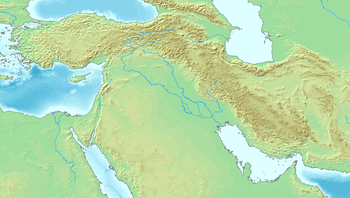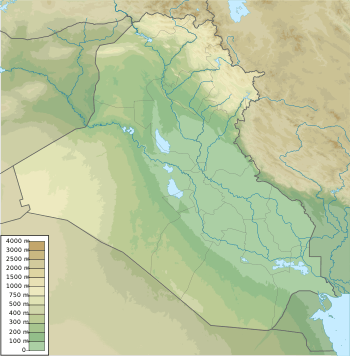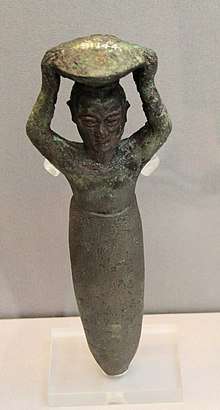Zabala (Sumer)
Zabala, also Zabalam (𒍝𒈽𒀕𒆠 zabalamki, modern Tell Ibzeikh, Dhi Qar Governorate, Iraq) was a city of ancient Sumer in what is now the Dhi Qar governorate in Iraq. Zabala was at the crossing of the ancient Iturungal and Ninagina canals, not far from Umma. The city's deity was Inanna of Zabala.
 Zabala Shown within Near East  Zabala Zabala (Iraq) | |
| Location | Dhi Qar Province, Iraq |
|---|---|
| Region | Mesopotamia |
| Coordinates | 31°44′36″N 45°52′36″E |
| Type | Settlement |
History
The first mentions of Zabala are in seals from the Jemdet Nasr period including a list of early sites - Ur, Nippur, Larsa, Uruk, Kes, and Zabalam.[1] The earliest historical record, a bowl inscription, indicates that Zabala was under the control of Lugalzagesi of Lagash.
In the Sargonic Period, Rimush of Akkad reports Zabala as attempting to rebel against the control of the Akkadian Empire:[2]
"Rimuš, king of the world, in battle over Adab and Zabalam was victorious, and 15,718 men he struck down, and 14,576 captives he took. Further, Meskigala, governor of Adab, he captured, and Lugalgalzu, governor of Zabalam, he captured. Their cities he conquered, and their walls he destroyed. Further, from their two cities many men he expelled, and to annihilation he consigned them"
Shar-kali-sharri and Naram-Sin both reported building a temple to the goddess Inanna in Zabala. [4]
After the fall of Akkad, Zabala came into the sphere of the city-state of Isin as reported by the year names of several rulers including Itar-pisa and Ur-Ninurta. The town was later subject to Abisare of Larsa, who's year name reported the building of the "Favorite of Inanna of Zabalam" canal.[5]
During the Ur III period, Zabala was controlled by the Ur governor in Umma which was the capital of Umma Province.[6]Cuneiform texts state that Hammurabi built Zabala's temple Ezi-Kalam-ma to the goddess Innana.[7] The temple of Inanna in Zabalam is the subject of hymn 26 in the temple hymns of Enheduanna.
Archaeology
Beginning in the early 1900s, a great deal of illegal excavation occurred in Zabala. An example of writing from the time of Hammurabi was removed from Zabala during this period.[8] This activity reached a new height in the 1990s, at which time the Iraqi State Organization of Antiquities and Heritage appears to have authorized an official excavation, the first at the site. It is not clear that the results were ever published. A further outbreak of archaeological looting at Zabala broke out after the 2003 War in Iraq.
Notes
- Green, M.W., A note on an archaic period geographical list from Warka, Journal of Near Eastern Studies, pp293-4, 1977
- Hamblin, William J. (2006). Warfare in the Ancient Near East to 1600 BC: Holy Warriors at the Dawn of History. Routledge. pp. 93–94. ISBN 978-1-134-52062-6.
- "CDLI-Archival View". cdli.ucla.edu.
- Mari A. Gough, Historical Perception in the Sargonic Literary Tradition: The Implications of Copied Texts, Rosetta, University of Birmingham
- The Rulers of Larsa, M. Fitzgerald, Yale University Dissertation, 2002
- The ruling family of Ur III Umma. A Prosopographical Analysis of an Elite Family in Southern Iraq 4000 Years ago, J.L. Dahl, UCLA disertation, 2003
- Tablet MS 1876/1 in the Schøyen Collection
- "A Stray Sumerian Tablet: Unravelling the story behind Cambridge University Library's oldest written object". Retrieved March 14, 2018.
See also
- Cities of the ancient Near East
References
- Andrew George, House Most High: The Temples of Ancient Mesopotamia (Mesopotamian Civilizations, Vol 5), Eisenbrauns, 1993, ISBN 0-931464-80-3
- B. Alster, Geštinanna as Singer and the Chorus of Uruk and Zabalam: UET 6/1 22, JCS, vol. 37, pp. 219–28, 1985
